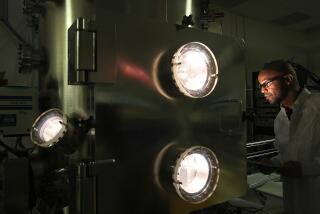Aerojet Rocketdyne to lay off about 150 workers in Canoga Park
About 150 employees at rocket engine maker Aerojet Rocketdyne in Canoga Park were told Wednesday that they would be laid off as part of a companywide reduction that the company says is related to last year’s merger.
Aerojet Rocketdyne was created by the sale of Rocketdyne to GenCorp Inc. for $550 million, a deal that was finalized last summer. It brought together two major California rocket companies — and longtime competitors. GenCorp already owned Aerojet, the Sacramento aerospace firm founded in 1942.
As a result, there were redundancies in the workforce and the company decided to cut about 5%, or 254 workers, which will be effective Monday. Besides the Canoga Park layoffs, about 50 workers in Sacramento and another 50 elsewhere in the U.S. will be let go.
“We’re trying to notify everyone that are going to be affected,” said Glenn Mahone, an Aerojet Rocketdyne spokesman. “At this point, there are no plans for additional cuts.”
The Sacramento company has about 5,300 employees nationwide, including about 1,200 in Canoga Park, where engineers and technicians build rocket engines for NASA, military rockets and missiles.
Aerojet Rocketdyne is perhaps best known as the maker of the space shuttles’ main rocket engines.
Now that the shuttle program has ended, NASA has outlined its engineering design for its next launch system. Aerojet Rocketdyne will supply both the first- and second-stage liquid hydrogen rocket engines, but NASA has not provided specifics on where and when the nation will travel next in the solar system.
Without a defined national space policy, Aerojet Rocketdyne will struggle, said Marco A. Caceres, space analyst for the aerospace research firm Teal Group Corp. of Fairfax, Va.
“In any merger, there are going to be layoffs,” he said. “The bigger question is what kind of demand is there for Rocketdyne’s products and what comes next for the company.”
In the early days of rocketry, Aerojet, Pratt & Whitney and Rocketdyne engaged in a bitter rivalry for lucrative U.S. government work.
Now the rocket engine makers compete as one entity in a shifting space industry. NASA and telecommunications companies are increasingly looking to commercial space companies such as Space Exploration Technologies Corp., or SpaceX, in Hawthorne.
On its own, SpaceX builds its Dragon capsule and the Falcon 9 rocket that lifted the Dragon into orbit. By contrast, the missions and overall design of NASA’s previous space-going vehicles were tightly controlled by the government and contracted to aerospace giants such as Boeing Co. and Lockheed Martin Corp., which in turn would subcontract work on rocket engines.
SpaceX has disrupted the market and offers its rockets at a discount from other companies. This sales pitch has appealed to the government at a time when spending on military hardware is expected to shrink.
The Air Force pays billions to a sole provider to launch nearly all of its spy satellites and other high-profile spacecraft, without seeking competitive bids. That provider is United Launch Alliance, a joint venture of Lockheed and Boeing, with Aerojet Rocketdyne providing engines.
Now there are indications from the government that SpaceX will be allowed to compete for those contracts as well.
“No one in the military or at NASA is inclined to pay as much as they have for rockets in the past decade,” Caceres said. “There might be some possibilities out there for Rocketdyne, but they’re not obvious.”
Employment in the Southland aerospace industry has declined from 83,480 in 2002 to 65,130 in 2012, according to Los Angeles County Economic Development Corp.
The round of layoffs at Aerojet Rocketdyne is the latest chapter of consolidation in the aerospace industry, which has unfolded over the last two decades and has cost tens of thousands of jobs throughout the Southland.
Rocketdyne engineers were at the forefront of developing engines in the days of slide rules and drafting tables, before advanced computers took a central role. The company supplied the major engines for the colossal Saturn rocket that put man on the moon.
By 1965, the company had about 17,700 workers in California.
At the time, most rocket engines were one-of-a-kind chemistry sets — good for one flight only. But that changed in the early 1970s, when NASA began the space shuttle program.
The agency wanted reusable engines to propel the 2,250-ton shuttle assembly as high as 384 miles above Earth.
The company tested its engines in the Santa Susana Mountains, now a cleanup site because of health risks associated with soil contaminated by years of rocket and nuclear testing.
The storied site — once swarming with engineers and technicians toiling on various programs — is nearly empty compared with the boom times. The scores of massive machines once humming and churning out parts for spacecraft now sit dormant and are set for closure at the end of the month.
Much of the workforce has been moved to a larger facility a few miles away on DeSoto Avenue.
Twitter: @wjhenn







